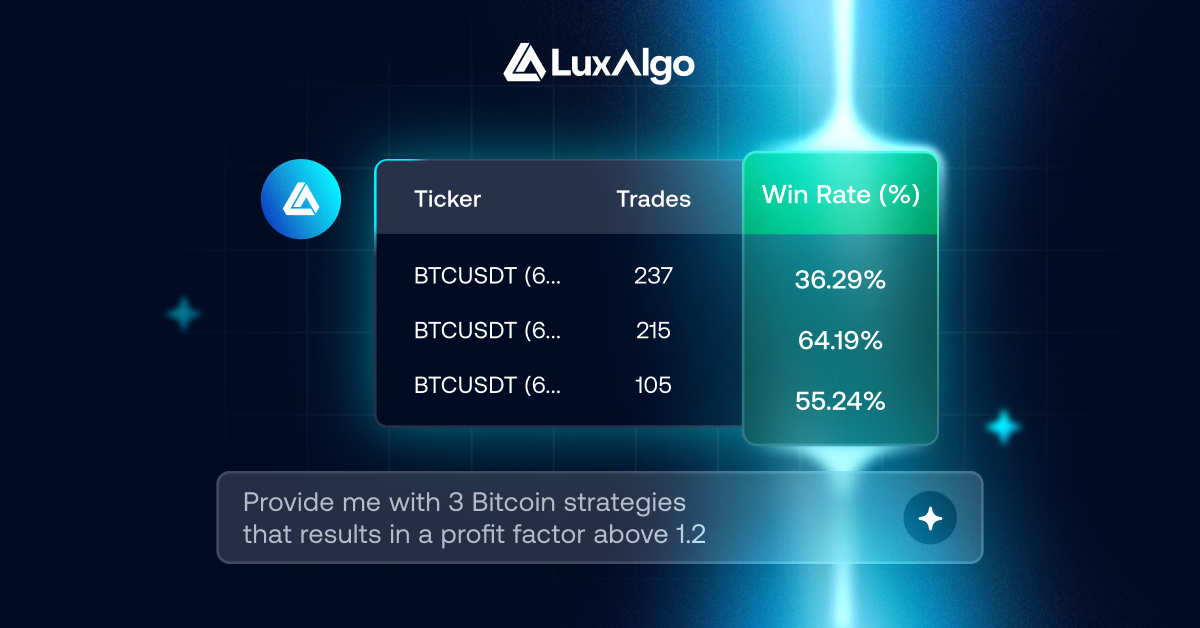Explore different prop firm challenges to find the best fit for your trading style, budget, and risk tolerance for funding success.
Prop firm challenges test your trading skills before giving access to firm capital, here’s what you need to know:
-
Types of Challenges:
- One-Phase: Single evaluation stage, faster but higher pressure.
- Two-Phase: Two stages, more time to prove consistency.
- Instant Funding: Immediate capital access, no evaluation but higher fees.
- Success Rates: Only 5%-10% pass because of strict rules on profit targets, drawdowns, and timelines.
-
Best Fit by Trading Style:
- Scalpers: Instant funding (no profit targets, but high costs).
- Day Traders: Two-phase (balanced rules, manageable targets).
- Swing Traders: Two-phase (accommodates market fluctuations).
- Costs: Entry fees range from $50 to over $1 000, depending on the challenge type. Full LuxAlgo plan pricing is listed here.
- Key Factors: Match the challenge to your trading style, budget, and risk tolerance. The LuxAlgo AI Backtesting Assistant platform can simulate challenge rules to help you pick the best option.
Quick Comparison:
| Challenge Type | Difficulty | Time to Funding | Upfront Cost | Best For |
|---|---|---|---|---|
| One-Phase | Medium | Fast | Higher | Experienced traders |
| Two-Phase | Medium | Medium | Moderate | Consistent traders |
| Instant Funding | None | Immediate | Highest | Confident, ready traders |
Choose wisely to align your trading goals with the right challenge structure. For more examples of funded-trader analytics, browse the free LuxAlgo Library of indicators.
1-Step vs 2-Step Prop Firm Challenges | Best Prop Firm Challenge Type
Types of Prop Firm Challenges
Choosing the right structure is crucial for traders aiming to secure funding. Each format has its own rules, timelines, and risk limits that can affect your path to funding. Below, we break down the main types so you can find the one that best matches your trading style and goals. If you need deeper insights into capital preservation, the LuxAlgo risk management blog explains practical techniques.
One-Phase Challenges
In a one-phase challenge, the entire evaluation is condensed into a single stage. Maximum drawdown limits often sit at 5%-10% and daily loss limits at 4%-6%.
This format is ideal for traders looking for a quicker evaluation. For example, FundingPips shared a $100 000 one-phase challenge (January 14 2025) with a $4 000 daily loss cap, a $6 000 overall drawdown, and a $10 000 profit target. Setting your own daily limit below those thresholds is generally safer [1].
Two-Phase Challenges
Two-phase challenges take a more gradual approach. Stage 1 usually requires an 8%-10% profit target, while Stage 2 drops to about 4%-5%, emphasizing consistent performance. You can rehearse each phase inside the LuxAlgo AI Backtesting Assistant docs to see how your strategy behaves over longer windows.
Instant Funding Options
For traders who want immediate capital, instant funding skips the evaluation. Drawdown rules apply from day one and profit splits can reach 80%-90%, but costs are highest.
The table below highlights key differences between these formats:
| Challenge Type | Difficulty | Time to Funding | Upfront Cost | Best For |
|---|---|---|---|---|
| One-Phase | Medium | Fast | Higher | Experienced traders |
| Two-Phase | Medium | Medium | Moderate | Consistent, methodical traders |
| Instant Funding | None | Immediate | Highest | Confident, ready-to-go traders |
How to Match Challenges with Your Trading Style
The challenge you select should suit your trading approach, risk appetite, and available screen time. You can cross-reference drawdown behaviour with live momentum cues using the Signals & Overlays toolkit, PAC toolkit, or Oscillator Matrix toolkit on TradingView. You can also scan for real-time setups via the S&O Screener.
Scalping focuses on rapid, small gains, often dozens of trades per day. For scalpers, instant funding is most convenient because there is no percentage target. That said, the tighter max-drawdown can be unforgiving.
Day trading suits a two-phase challenge. Balanced drawdown limits and time windows align with the typical hold period of a few hours.
Swing trading pairs well with two-phase challenges. The looser daily limits give trades room to run overnight. If you want to test holding positions through weekends, load the OSC screener to spot trend persistence before the market closes.
Using LuxAlgo AI Backtesting Assistant to Pick the Right Challenge

Choosing a prop-firm challenge becomes simpler when you can stress-test your strategy under realistic rules without risking capital. The LuxAlgo AI Backtesting Assistant lets you do exactly that by applying drawdown, profit-target, and time-limit rules to historical data. You can explore setup ideas in the Fetching Strategies guide and refine them with the Backtesters dashboard.
Key benefits:
- Simulate drawdown constraints for scalping, day-trading, or swing-trading methodologies.
- Flag breaches of challenge rules, then adjust entry–exit or risk parameters on the fly.
- Run bulk scenarios across multiple assets, drawing on the free exclusive algos for confluence.
Pros and Cons of Each Challenge Type
Balancing budget, risk, and speed is critical. Table below summarises the trade-offs. You can trial each structure inside the LuxAlgo platform before paying a challenge fee.
| Challenge Type | Pros | Cons |
|---|---|---|
| Two-Phase Challenge | Lower cost, gradual evaluation, encourages consistency | Longer journey, two evaluations, sustained effort required |
| One-Phase Challenge | Faster funding, single hurdle, balanced cost | High pressure, no second chances, larger initial fee than two-phase |
| Instant Funding | Immediate capital, no performance stress | Highest price, no skill-building buffer, significant upfront risk |
Conclusion
Succeeding in a prop-firm challenge depends on matching your style, experience, and budget to the right format. Newer traders may benefit from two-phase challenges, whereas disciplined pros might opt for one-phase or instant funding. Always verify your strategy with the AI Backtesting Assistant to avoid costly trial-and-error.
FAQs
How do I choose the right prop-firm challenge for my trading style and risk tolerance?
Start by evaluating your trading style (scalping, day trading, or swing trading) and align it with a challenge’s timeline. Two-phase challenges suit patient development, while one-phase rewards faster outcomes. Match these requirements with disciplined risk management. You can test every rule set directly in the LuxAlgo AI Backtesting Assistant.
What are the best strategies to increase your chances of passing a prop-firm challenge?
Keep risk per trade between 1%-2%, always set stop-loss orders, and backtest a rules-based strategy before you start. Emotional discipline is equally vital, avoid revenge-trading and stick to your plan.
How can the LuxAlgo AI Backtesting Assistant help me choose the best prop-firm challenge for my trading style?
The assistant simulates drawdown, profit factor, and win-rate metrics under the exact rules of different firms. Whether you scalp, day trade, or swing trade, you get a data-driven preview of how well you could perform before paying any challenge fee.
References
- LuxAlgo Home
- LuxAlgo Pricing
- AI Backtesting Assistant – Main
- AI Backtesting Assistant – Chat
- AI Backtesting Assistant – Docs Intro
- AI Backtesting Assistant – Fetching Strategies
- LuxAlgo risk management blog
- Signals & Overlays Toolkit Intro
- Price Action Concepts Toolkit Intro
- Oscillator Matrix Toolkit Intro
- OSC Screener Intro
- S&O Screener Intro
- LuxAlgo Indicator Library
- LuxAlgo Backtesters Dashboard
- Exclusive Algos Overview
- FundingPips
- FundingPips – One-Step Tips
- Funding Frontier – Prop-Firm Guide
- YouTube – Challenge Overview




